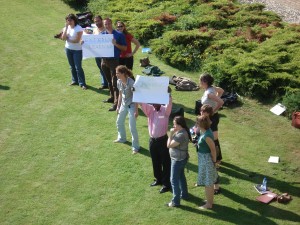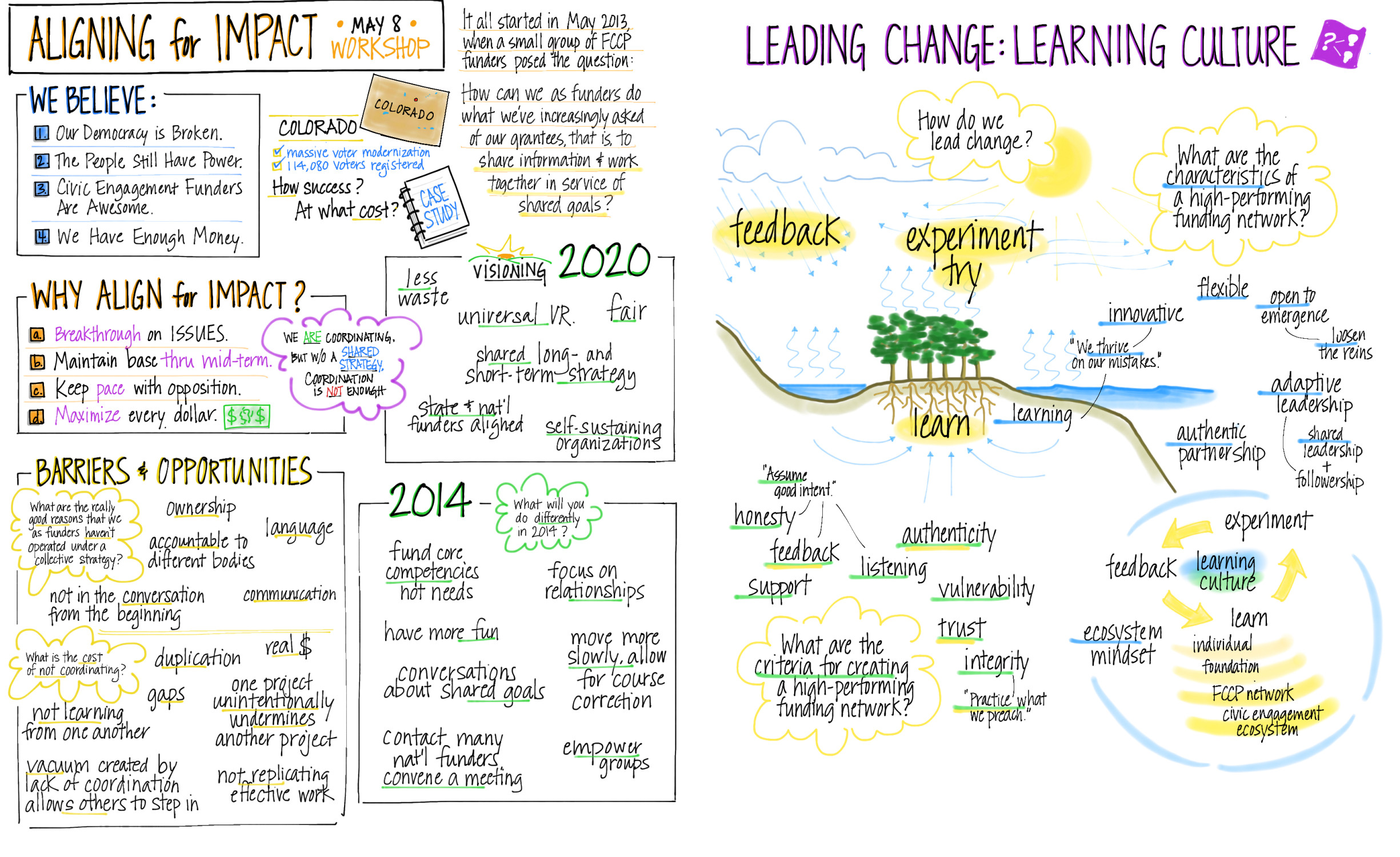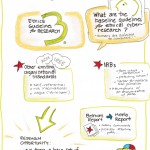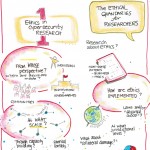I’m running like a maniac today, but this post from Eugene Eric Kim is to spot on to pass by. My highlights are the attention to online meeting design, shared visuals and slowing down to really notice what is going on. I hope that makes you want to click in and read. Image from the blog post by Amy Wu. Click to see the whole thing!
Category: harvesting
Ideas for Bringing Online Participation into Offline Events
 Earlier this week my friend Doris Reeves-Lipscomb invited me into a conversation with Suzanne Daigle to explore options for including online/distributed participation in the upcoming Open Space on Open Space (OSONOS) in St. Petersburg Florida May 16-19. Having been to an OSONOS, I’d love to go, but the arrival of granddaughter #2 sometime soon says “STAY HOME!” (And if you don’t know about Open Space, check here –> it is wonderful!)
Earlier this week my friend Doris Reeves-Lipscomb invited me into a conversation with Suzanne Daigle to explore options for including online/distributed participation in the upcoming Open Space on Open Space (OSONOS) in St. Petersburg Florida May 16-19. Having been to an OSONOS, I’d love to go, but the arrival of granddaughter #2 sometime soon says “STAY HOME!” (And if you don’t know about Open Space, check here –> it is wonderful!)
Doris took terrific notes during the call and I’ve augmented them with many links and some examples. I thought it might be nice to share them because we often have questions about the online/offline interconnections for face to face events and graciously, Doris and Suzanne agreed. I should spend more time editing and amplifying, but if I waited to “find time” for that, I’d never get it up ! I’ve also blogged about this a lot here on the blog, and on my wiki, so a little searching may yield value! But if I don’t post this now… That also means, there are tons of gaps and opportunities for you to add your knowledge in the comments! PLEASE!
Recommendations from Skype Call—Nancy White, Suzanne Daigle, Doris Reeves-Lipscomb – April 30, 2013
Before Conference
Purpose
- Consider WHY you want to connect online and offline.
- To harvest and share out what is going on (social reporting and more on social reporting. Don’t miss David Wilcox’s blog as well.)?
- To facilitate virtual participation in parts or all of the OSNOS? To bring in a particular voice/voices into a particular OS session or plenary?
- To tap outwards to the network when questions arise at the F2F? Or something else? Having a sense of purpose helps inform process and technology stewardship. just weave the network a bit? Help others see and discover it?
- Start where there is energy: Create opportunities for remote/ virtual engagement with the handful of OS practitioners who are ready for it. Identify both people who will be at the event and those online who would like to connect from afar during the event.
- Understand there may be resistance. Face to face gatherings are precious and some find the effort to include those “not in the room” detracts from their experience — or they have that perception or past experience. Go gently.
Process
- Verify availability and process for online access/bandwidth. (Yeah, this never goes as planned or promised! Having people with mobile web access is a great fallback!)
- Create a hashtag for WOS and share widely. Create posters for it and place around event (and especially near any instructions on how to log on to the wifi)
- Use Open Space email list to find out who already uses the online and build on the technologies they already use. Affirm preferred communication tools for use at WOS
- What would they like to do? What might they commit to doing?
- Then get out of their way. Don’t put yourself too much in a hub role or you won’t have time or attention for anything else. Use the network!
- Technology Stewardship: Identify, practice with and debug virtual tools that you have relied on before—Crowdvine, WordPress, etc. — or plan to add to your technology configuration.
- Explore examples of good online events. What relates to good offline events? There IS a lot in common!
- For social reporting, consider a small team comprised of millenials/digitally competent OS practitioners and prepare a social reporting plan. (My social reporting bookmarks. A few social reports.)
- For virtual real time interaction, identify time zone issues (I like to make a little map with people online in their time zone. It is easy to forget otherwise.)
During Conference
- Be clear: Announce at beginning how people can opt-in/opt-out of the use/uploading online of their pictures/words via Twitter, Facebook, Crowdvine, etc. and showing opt-out preference with dot on badge; review any other decisions made to work virtually—who, when, how, where
- Affirm hashtag for all outgoing tweets, communications, blog posts, etc. (post those posters!)
- Social Reporting Stuff:
- Tweet/FB images and short narratives of what is going on.
- Connect particular practitioners who have an interest in each others’ practice
- Do 1-2 minute interviews and post online, then tweet url (examples from 2 conference where I was social reporting : https://www.youtube.com/watch?v=LHtv69eam5U and https://www.youtube.com/watch?v=N-yATDNzV_I, both of whom are OS community members!)
- Point to blog posts or wiki pages where session reports are posted
- Towards the end, gather super short reflections (sometimes it is fun to have people write their key insight, etc on a sheet of paper in broad marker, hold it up and then you film them saying out loud. Then you edit together. Here are some unedited examples: https://www.youtube.com/watch?v=eJsvQpui7-0 and https://www.youtube.com/watch?v=Mofj3zDQgzc
- For virtual participation, identify one or more OS sessions and offer them at the market place with the explicit offer to include virtual participants. (Be prepared for no one or too many to show up!). Consider debriefing these experiences to build knowledge and process for future events. (Here is a story of one I did at a conference – not Open Space tho!)
- Open an OS session using Google Hangouts or Skype with WOSonOS circle or Skype contact list, etc. if you wish to use these tools or encourage others to use them.
- Link reports and other harvests out via social networks, ie. use sociable plugin on WordPress for simultaneous messaging out to Twitter, Facebook, etc.
- (If you have decided to do this) use the OS format/Marketplace first round for setting up virtual participation leaders/practice
- Bring others in by exporting key bits of conference to them through one minute mobile interviews or other kinds of social reporting; have interactive discussion online forum ready for conversations to happen
- Use Storify to curate WOSonOS tweets
- Consider asking for and harvesting post event reflections. (Example here of one of my reflections. And another.)
Attitudinally
- Appreciate that both Millennial and new-bees can be fresh eyes in capturing important elements at the conference with onsite/offsite participants. They don’t have to be Open Space experts!Think of the relationship to Open Space bumblebee and butterfly kinds of functions.
- Don’t assume non-Millenials aren’t’ comfortable with and don’t use social media tools. Some of us boomers are quite adept.
- Reflect/debrief (but don’t over do it) and share what you learn back out to the wider community.
- Go with the flow. Plan and be prepared to abandon the plan. Stay present and enjoy!
Building a Virtual Tour of Online Communities
 This is the second post about touring existing online communities as a learning journey for those building or sustaining their own communities. (Part 1 is here.) This one is about the nuts and bolts of doing a live tour of online communities. The first post laid out purpose, identification of potential communities to tour, and criteria for review and evaluation. So now lets talk about HOW to run the tour. This is nuts and bolts time!
This is the second post about touring existing online communities as a learning journey for those building or sustaining their own communities. (Part 1 is here.) This one is about the nuts and bolts of doing a live tour of online communities. The first post laid out purpose, identification of potential communities to tour, and criteria for review and evaluation. So now lets talk about HOW to run the tour. This is nuts and bolts time!
Planning
- Pick your web touring technology. For this sort of event, I like to have a tool with fairly easy screen sharing and a shared chat room for note taking. I use a white board or slides to share the initial overview and questions.
- Set the date. Let your “tourists” know date, time and any technical requirement. This may mean needing to be online, have a headset/mic or an appropriate telephone dial in option.Confirm your communities. Get permissions as appropriate if you plan to use your personal log in to tour any private communities!
- Set up a URL list that can work both within your web technology and on a separate web page as back up. Plan a SHORT intro narrative to each community. Decide what pages you will visit and why. See the first post! I like to throw the URLs and short descriptions on to a Google doc and share it with the tourists in advance.
- Test your URLs within the web meeting tool. Should they be links? Preloaded? Do you need username/password to log on to any private sites?
- As backup, grab a basic set of screen shots of each community in case your web touring technology fails. Yes, it happens! Always have a plan B.
- If you have a co-facilitator, define each of your roles.
- It is often useful to have one person help folks if they have any technical needs, while the other runs the tour.
- Consider how you want to capture questions as you go — sometimes you will need to research and come back later with answers. Encourage the tourists to take notes if that fits your culture!
- Send an email with the login information and any preparation you would like the tourists to do. I often send a short piece on community PURPOSE and some of the questions I mentioned in the first post.
Running the event
- Log in early and make sure everything is working. Have an email prepped to resend in case anyone contacts you saying “I lost the url/login/etc.
- If you decided to preload URLs on separate whiteboards, etc, get that all set up. Set up any polls or questions on other white board pages or have them handy to cut/paste in.
- If you are recording the tour, don’t forget to hit the old “record” button once you start.
- When you start with your participants, give an overview of the tour process. It might go something like this:
- We are going to look at X different communities today. I’m going to use the screen sharing tool (or whatever you plan) so I’ll be “driving” the tour, but please, if you see something you’d like me to click on, let me know. There is a slight lag with the screen sharing so speak up as soon as you can!
- I want to review a couple of questions we should keep in mind as we tour (then I review the questions.)
- Encourage shared note taking (I often use the chat room in the webinar tool).
- Do you have any questions? (Answer them..)
- Start…
- Pause often for questions, observations.
- Between communities, do a quick recap asking for observations and answers to questions. Sometimes it is worth going deeper and seeing fewer communities…
- Leave at least 25% of the time at the end for reflection and next steps.
Follow Up
- If you are recording the event, capture the recording and share the URL.
- Clean up and share any collective notes taken during the event.
Do you have any other suggestions or ideas? Resource pointers? Please, chime in!
Graphic Recordings from the AaTC Cyber Cafe
In between trips last quarter I had the pleasure of being a virtual graphic recorder for the SAaTC Cyber Cafe. My work was commissioned for NSF through weDialogue at http://www.wedialogue.com
The day long event was structured with plenary and World Cafe breakouts. I captured two rounds of the afternoon breakouts — the topics were heady, so I had to work pretty fast.
You can see captures from the presentations http://www.satc-cybercafe.net/presenters/ and the Cafe sessions http://www.satc-cybercafe.net/potential-research-topics/satc-cyber-cafe-research-topic-breakouts/ The three I did are below. I’m experimenting with a gallery. Let’s see how it works!
Getting to Graphically Record Locally for Stephanie West Allen
Lately I’m more on the road than home. I’ve been incorporating visual methods into all my work (see here and here) but it will be fun to do some local graphico stuff. Tonight our local informal group of visual practitioners joins for conversation, snacks, and of course, drawing. Then in a week, I get to record Stephanie West Allen’s presentation at the NR Dispute Resolution conference. I’ve known Stephanie online for quite some time, and finally, face to face! (Thanks to neighbor Rina Goodman!) Here are the deets:
I spoke at this annual conference two years ago and found the people—organizers, presenters, and attendees— to be warm, curious, skillful, and farsighted. They are also a brainy gang, paying attention to neuroscience. For the second year in a row, Dr. John Medina is speaking!
I am very happy to be returning to Seattle, and look forward to seeing old faces and meeting new conflict resolution pros. Below is the description of my program. Click to see the full brochure and read the program and to register.
Exciting news: My program will be graphically recordedby Nancy White, an international leader among graphic recorders. (She’s in Zambia right now.)
My presentation:
Total-Brain Mediation: The Whole Brain and Nothing but the Truth
Presenter: Stephanie West Allen, Allen & Nichols Productions, Inc., Denver, CO
The field of conflict resolution is now filled with neuroscience myths, fiction and urban legends. We will look at what we REALLY know right now and how we can use that valid and accurate knowledge to move forward in the field. The best way to resolve conflict and to serve our clients is to make sure that we are using the complete brain, not just bits and pieces. Unfortunately much of mediation today is half-brained, at best. We neglect those parts of our brain that contain genuine, sustaining creativity and wisdom. This seminar will be mind-changing. Attendees will learn how to use the whole brain and nothing but the truth. Based on the latest in the neuroscience of learning, the seminar will be interactive, novel, fun … and maybe a bit messy.via idealawg: Join us in Seattle May 4-5? 19th Northwest Dispute Resolution Conference.




